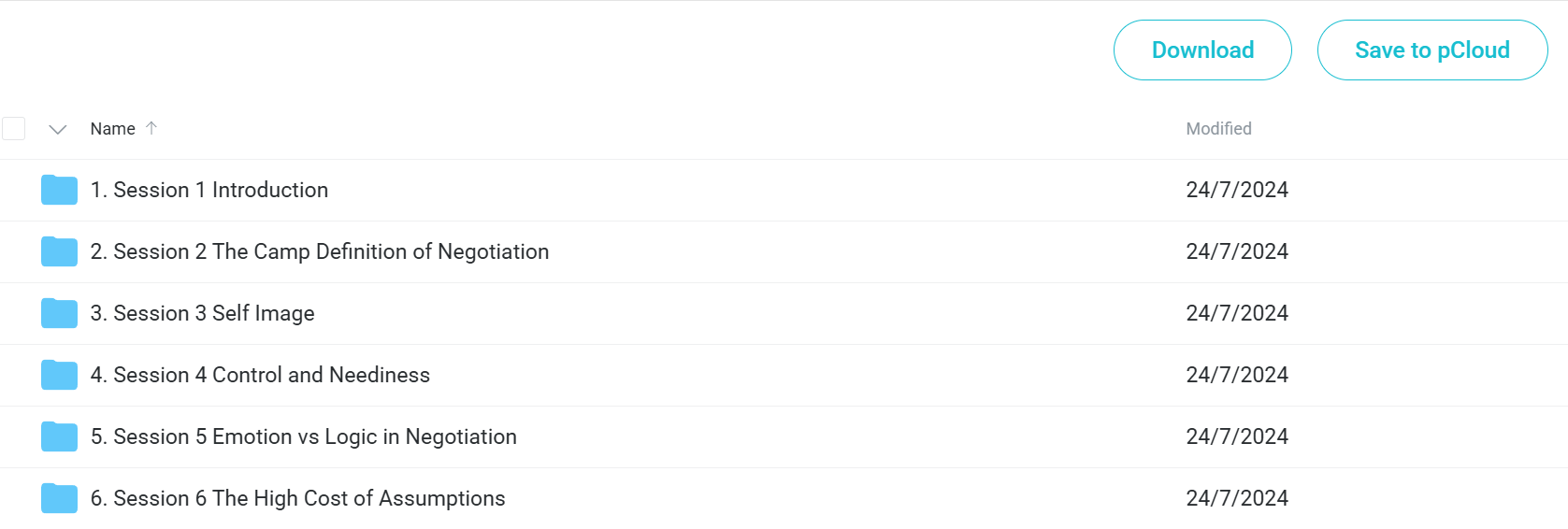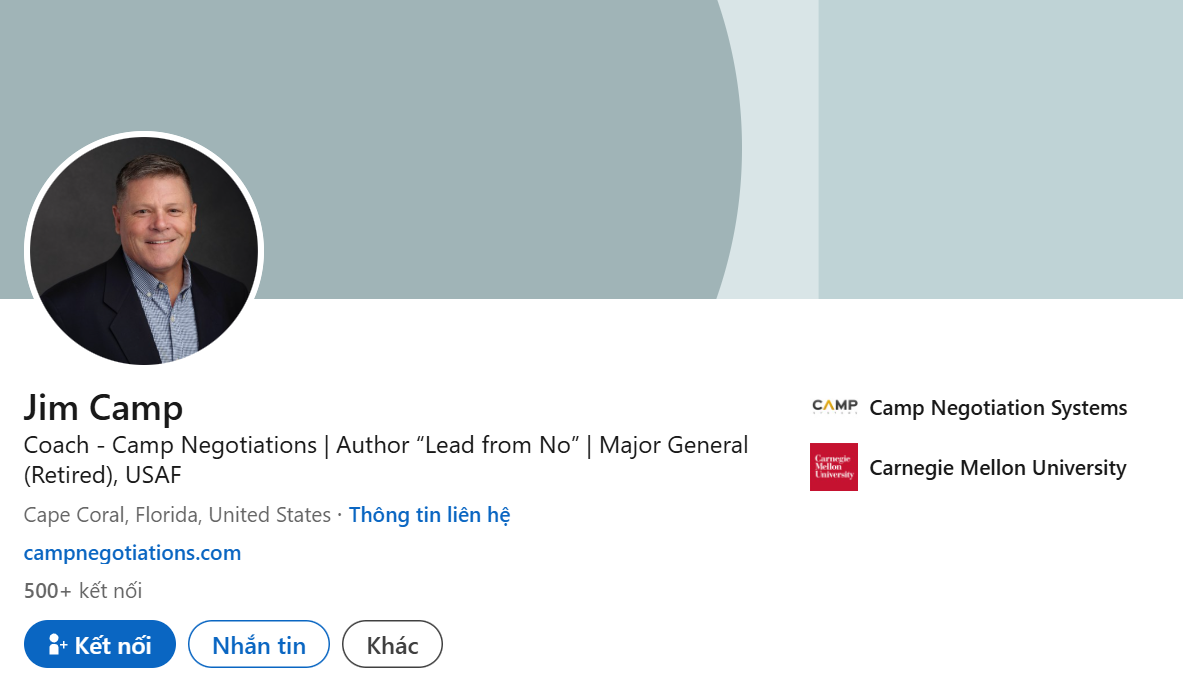Jim Camp – Live Negotiation Workshop Series
$597.00 Original price was: $597.00.$40.00Current price is: $40.00.
Jim Camp Live Negotiation Workshop Series Course [Instant Download]

What is Jim Camp Live Negotiation Workshop Series?
Jim Camp Live Negotiation Workshop Series is a negotiation training course teaching you how to win deals without compromise.
This 6-hour workshop shows Jim Camp himself demonstrating his proven system used by IBM, Intel and 500+ major companies.
You’ll master emotional control, clear objectives, and strategic use of “no” to gain better outcomes in any negotiation. The course includes practical tools like preparation checklists and decision frameworks you can download and use immediately.
📚 PROOF OF COURSE



What you’ll learn in Live Negotiation Workshop Series:
The Live Negotiation Workshop Series teaches you professional negotiation skills directly from Jim Camp. Here’s what you’ll learn:
- Negotiator’s mindset: Control your emotions and see why you don’t need to compromise to succeed
- Strategic behaviors: Understand your adversary’s world to find solutions that work for both sides
- Structural components: Learn the 6 core elements and 3 key aspects needed in every negotiation
- Practical tools: Use the same PDF templates that professional negotiators use to plan their deals
- Real-world application: Watch Jim solve actual negotiation problems you face every day
- Self-assessment: Test your negotiation skills before and after training to see your improvement
After finishing this workshop, you’ll have both the mindset and practical skills to handle any negotiation with confidence.
Live Negotiation Workshop Series Course Curriculum:
✅ Module 1: Mindset
The Mindset module lays the mental groundwork for Camp’s negotiation system by questioning common beliefs about negotiation. Students learn how their self-view, emotional control, and clear thinking create the foundation for successful negotiation.
In Session 1, students are introduced to the basic ideas of the Camp Negotiation System and learn why usual negotiation methods often don’t work. This first session prepares students for the new ways of thinking to come.
Session 2 gives a fresh definition of what negotiation really is, moving away from the typical win-win thinking. Camp explains negotiation as a clear process with specific steps and results, providing direction for all other techniques.
The Self-Image session shows how your view of yourself directly affects your negotiation results. Students learn to spot and fix self-image issues that get in the way of good negotiation.
In the Control and Neediness session, students discover how showing desperation weakens their position. The course teaches ways to stay in control by removing neediness and developing real options.
Session 5 looks at the important difference between emotion and logic in making decisions. Students learn why emotional decisions lead to poor outcomes and how to keep negotiations focused on logical thinking.
The Assumptions session ends the mindset module by showing how unproven beliefs hurt negotiations. Students learn methods to identify and question assumptions through effective asking and checking.
✅ Module 2: Behaviors
The Behaviors module turns mindset principles into practical negotiation actions. Students learn specific ways to communicate that create clear pictures, build relationships, and gain advantages in negotiation.
Mission and Purpose sessions teach students to set clear goals before starting negotiations. This clarity prevents aimless talks and emotional choices while providing a way to measure potential agreements.
The Power of Being Not Okay challenges the common belief that you must always appear confident. Students learn how showing some vulnerability and being comfortable with uncertainty can create advantages.
In the Blank Slate session, students master the skill of approaching negotiations without preformed ideas. This behavior prevents assumption-based mistakes and opens talks to creative possibilities.
Nurturing and The Strip Line sessions explore ways to build trust while keeping boundaries. Students learn to develop relationships without giving up their negotiation position.
The Questions section teaches specific asking techniques that help create a vision in the other person’s mind. Students learn how to form questions that reveal hidden information and guide decision-making.
Advanced Tools sessions cover specialized techniques including Reverse, 3+, and Connect methods. These tools help negotiators recover from tough situations and keep talks moving through complex negotiations.
Session 13 features a live negotiation showing the problems with win-win strategy. This real example demonstrates how Camp’s system works in actual situations, reinforcing earlier lessons.
✅ Module 3: Structure
The Structure module provides the organizing framework for using Camp’s negotiation system. Students learn how to systematically prepare, carry out, and control negotiations through structural elements.
The Negotiation Agenda session teaches students how to develop and control the negotiation process. Students learn to prepare plans that keep negotiations on track while staying flexible.
Finding Their Pain and Problem explores ways to identify the other party’s challenges. Students learn how understanding the other side’s difficulties creates leverage and helps develop solutions.
The Negotiation Budget session covers all resources involved in a negotiation, not just money. Students learn to set clear limits for what they can invest in the negotiation process.
In The Decision Process, students learn techniques for understanding and influencing how decisions are made. The session covers identifying who makes decisions, understanding their methods, and navigating approval systems.
✅ Module 4: Tools
The Tools module provides practical resources for using Camp’s negotiation system in real situations. Students receive concrete materials to prepare for, record, and learn from negotiations.
The Preparation Checklist session provides a complete framework for negotiation readiness. Students get a step-by-step approach to preparation that ensures they don’t miss any important elements.
The Review Log teaches students how to document and analyze negotiations to keep improving. This tool turns each negotiation into a learning opportunity, speeding up skill development through structured reflection.
Who is Jim Camp?

Jim Camp was a top negotiation expert who founded Camp Negotiation Systems. His approach changed how businesses make deals worldwide.
After serving as a Vietnam Air Force pilot, Camp gained decades of real negotiation experience. He taught his decision-based system to over 100,000 people.
Camp rejected “win-win” methods. Instead, he taught emotional control, clear objectives, and strategic use of “no.” Over 500 major companies use his system, including IBM, Intel, Cisco, and Merrill Lynch.
He wrote bestsellers “Start with No” and “NO: The Only Negotiating System You Need for Work and Home.” The Wall Street Journal called his method “the business world’s most popular negotiating method.”
Before his death in 2014, Camp recorded this workshop to share his knowledge. His techniques continue through Camp Negotiation Systems today.
Be the first to review “Jim Camp – Live Negotiation Workshop Series” Cancel reply
Related products
Best 100 Collection
Best 100 Collection
Personal Development
Seduction & Love
Personal Development
Personal Development
Personal Development
Best 100 Collection












Reviews
There are no reviews yet.